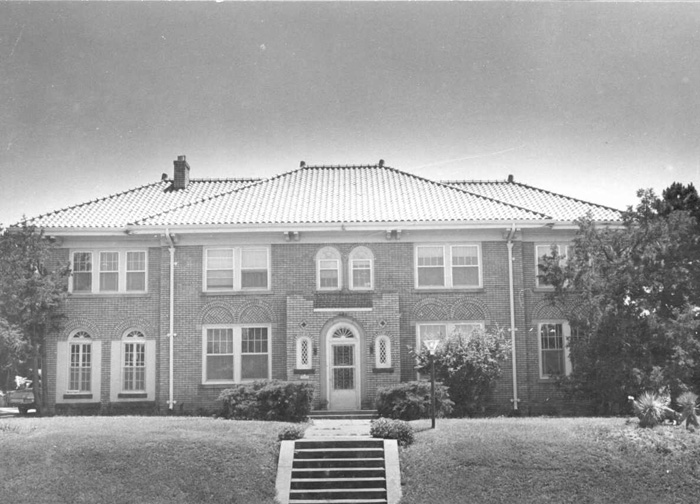600 Culbertson Drive

600 is a buff brick, green Spanish-tiled, hipped-roof house of large proportions. The first floor windows have brick arches over them with a basket-weave brick pattern on the tripendiums. The one-story entrance projection has an arched door with fan light and two small diamond-paned arched windows flanking it. The porch on the ground floor east wing has been enclosed. This house rises high above Lincoln Boulevard and has lovely old cedar trees surrounding it. A lot to the east has a tennis court hidden by hedges.
Gen. and Mrs. William S. Key 1928-1971
David Wakefield 1972
Oklahoma City oilman W.S. Key was a prominent figure in the political life of the state, as well as a former president of the Oklahoma Historical Society.
From 1924-1927 Key was warden of the Oklahoma State Penitentiary (OSP) under Governor M.E. Trapp, and from 1928 to 1932 he was chairman of the Oklahoma Pardon and Parole Board. Again, under Governor E.W. Marland, he served briefly as OSP warden, but resigned to become the administrator of the Works Progress Administration in Oklahoma for the New Deal. In his WPA post, Key supervised the building of fifty-three armories, 359 school buildings, scores of libraries and miscellaneous community buildings.
As candidate for governor in 1938, Key lost by only 3,000 votes out of 600,000 cast.
In his civic role, Key was president or chairman of the Oklahoma City Rotary Club, the Wardens Association of the United States, the state safety council, the Oklahoma City Chamber of Commerce (director) and the Salvation Army Advisory Board.
The title "General," which he carried for a number of years, dates from his appointment as major general in command of the 45th Division. As a national guard officer who came up from the ranks, he served as provost marshal for all U.S. forces in Europe on the staff of Gen. Dwight Eisenhower in 1942. For a five-day period in 1943, he was commander of all U.S. forces in Europe. After he retired from the service in 1949, he served as head of the Oklahoma Reserve Officers Association.
Key was born in Dudleyville, Alabama in 1889. He started his military career just after finishing high school there by joining the George National Guard in 1907. At Wewoka he founded the Key Hardware Company, the Key Theater, Key Funeral Home and the Wewoka Gas Company and joined the Oklahoma National Guard as a lieutenant. He married Irene Davis in 1913.
Key served on the turbulent Mexican border in 1916-17 and came out of World War I as a lieutenant colonel, after serving overseas for 17 months. His World War II service included forty-six months of overseas duties, a term of service as U.S. Representative on the Allied Control Commission in Hungary, and military decorations among which were the Distinguished Service medal with oak leaf cluster, the Legion of Merit, the Bronze Star, and the distinguished service medal.
Key was also a controversial figure in his own Lincoln Terrace neighborhood, where he fought a lengthy but unsuccessful battle for legal permission to sink oil and gas wells in the Lincoln Terrace addition. In 1937, Key named forty-six residents of the district in a federal court action after the state Supreme Court ruled that a 1936 ordinance throwing the city open to drilling did not supercede the neighborhood's plat restrictions.
Key died in 1959 the same day he was re-elected to the Chamber of Commerce board.
Mrs. W.S. Key was one of ten children of Mrs. Alice Brown Davis, who was the first woman appointed chief and who directed the activities of her tribe of the Seminole Indian nation.
© Lincoln Terrace Neighborhood Association | Oklahoma City